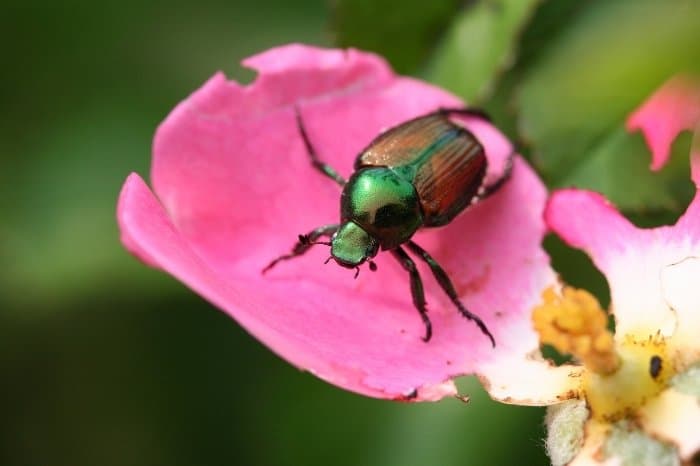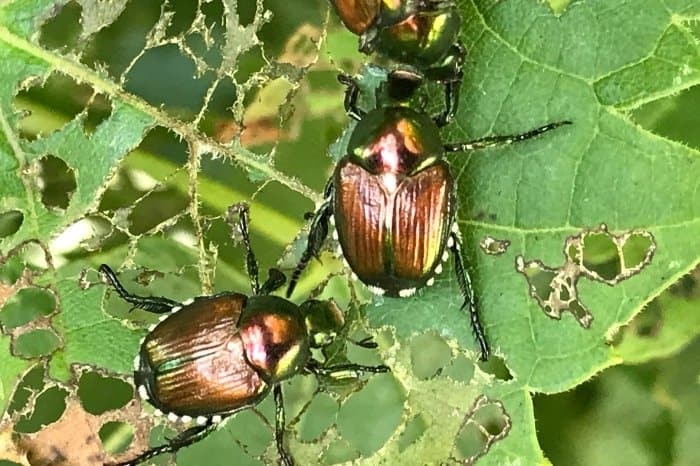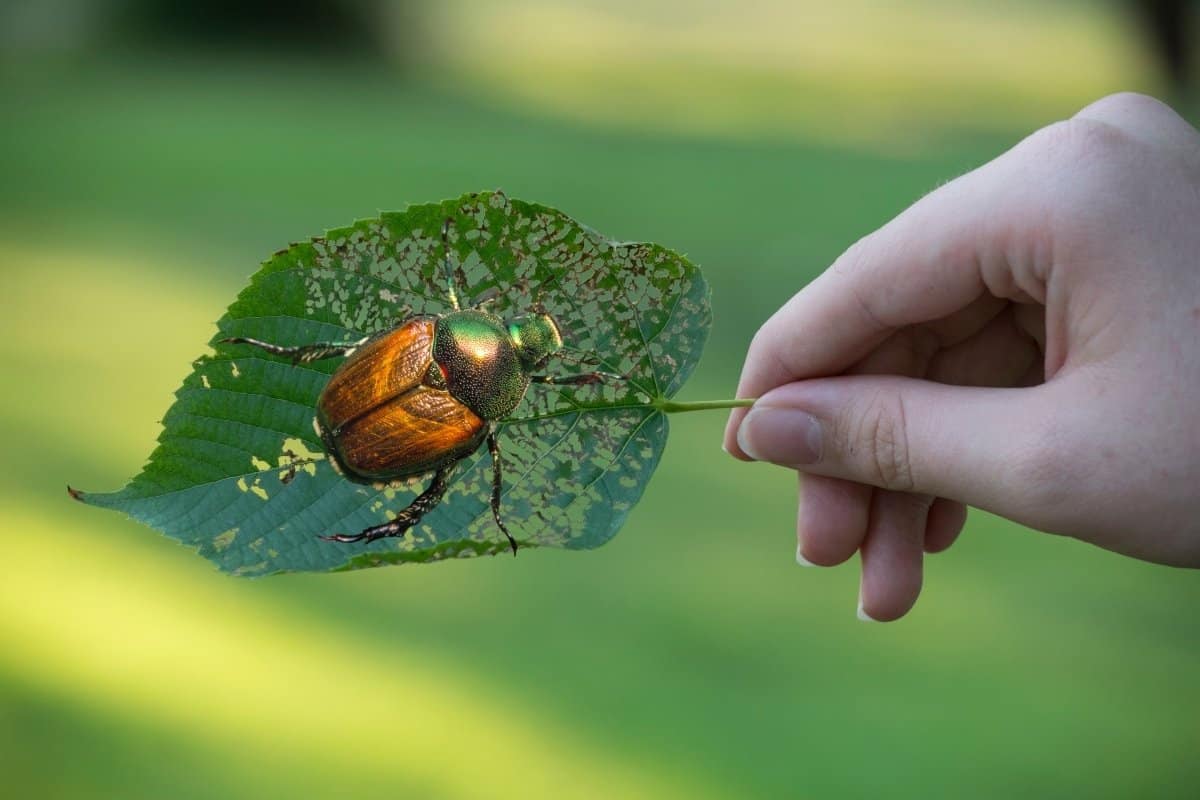Last Updated on January 31, 2022 by
Most Americans have been wondering do Japanese beetles bite due to their increasing numbers that continue to eat up most of their crop.
Popillia japonica Newman or the Japanese beetle is a well-known pest native to Japan. It is currently a big threat in America eating up shrubs, fruit trees, turf, etc.
Japanese beetles are the number 1 turf pest. It is estimated that this pest costs the ornamental and turf industry over $450 million annually trying to manage them.
It is common to find these destructive pests in flower gardens, vegetable gardens, shrubs, and fruit trees. They also infest golf courses, agricultural fields, parks, and woodlands.
Do Japanese Beetle Bite?
You already know that the Japanese beetles can be extremely destructive, but do they really bite? No recorded evidence suggests these beetles bite. They may try to pinch you with their mandibles, but they are too weak to hurt or to get through your human skin.
These beetles have rough spines on their legs, which feel prickly against your skin, but do not hurt. In short, the Japanese beetles bites cannot harm a human being!
Facts About These Beetles
- Japanese beetles were introduced by accident to New Jersey in 1916. They were allegedly hidden in iris bulbs shipped from Japan.
- These beetles continue to invade the United States by hitching rides on vehicles, freight, and even air cargo. Grubs and eggs continue to travel in the soil for the nursery stock.
- In their native country, they are not a major pest problem because of natural predators that eat them.
- These beetles like the sun. The adults prefer to feed and mate during the warm, sunny days.
- They are also attracted to roses, especially the yellow ones.
- When you approach the Japanese beetles, they lift their hind legs in an attempt to scare off predators.
- All the beetle species chew their food well before swallowing. This is a common trait that all beetle larvae and adult beetles share.
What Do Japanese Beetles Look Like?
- An Adult Japanese beetle measures about 1/3 to ½-inch long. It has a shiny, metallic-green body with bronze-colored wing covers. These bronze or copper-colored wing covers appear to be metallic under the sun. It has 6 small tufts of white hair along its side.
- Its Larvae – grubs or white grubs have a grayish-black rear end and a brown head. It is C-shaped reaching about 1-inch long when mature. The last body segment has hairs that are V-shaped located below the anal opening.
- The Pupa is about ½-inch long with a cream-colored body. It becomes light reddish-brown as it ages.
- The Eggs are creamy-white and oval. They are about 1/16-inch long when first laid, but as the embryos develop, the eggs enlarge up to double their initial size becoming almost round.

What Do Japanese Beetles Eat?
The beetles feed on flowers, foliage, or fruits of over 300 plant species across 79 plant classes. Their favorite plants include roses, grapes, hibiscus, raspberries, sassafras, linden, Norway maple, Japanese maple among others.
These beetles start at the top of a plant working their way downward eating everything on their way. Adults eat the entire upper side of the leaves leaving only the veins and midribs. This gives the leaves a skeletonized appearance – a sign many gardeners check for to know if they have beetles around.
To begin with, these beetles feed on low plants before moving to the foliage of trees. Larvae feed on the decayed matter in the soil and grassroots.
However, these beetles seldom damage other plants that include pear trees, evergreens, flowering dogwoods, red maple, lilacs, some ornamental flowers, and grains.
What Is The Lifecycle Of Japanese Beetles?
The Japanese beetles’ life cycle consists of 4 development stages called complete metamorphosis. The stages are egg, larvae, pupa, and adult. Adult Japanese beetles have a very short lifespan of 30-45 days on average. Mating happens on the food plants as they feed.
The female beetles later leave the plant on which they are feeding to find an ultimate place to lay the eggs. In each egg-laying session, the female beetle lays 1 to 5 eggs and deeply buries them under the soil at least 2 to 4 inches deep.
The Vegetable Garden Pest Handbook: Identify and Solve Common Pest Problems on Edible Plants
The work of the females is to feed, mate and lay eggs. They repeat this process every 24 to 48 hours until they have laid 40 eggs throughout their life cycle.
The eggs develop into larvae, known as grubs, and spends the fall and winter months in the ground developing into pupae. The larvae feed on crops or grassroots and thrive in well-moisturized soil and go through 5 molts before becoming a pupa.
The pupa reaches an adult stage in the early summer months. The adult leaves the ground and begins to look for plants to feed on. These new adults begin to release pheromones that attract other adult beetles for mating to start again.
The new cycle begins all over again as long as beetles live.
How To Spot Japanese Beetles In Your Plant
It is easy to spot or notice the infestation of beetles in your garden. You will begin to notice the skeletonization of the leaves of trees and plants or some brown patches on the grass.
Your flower blossoms may also look stunted or see a jagged pattern at the edges of the petals.

With a closer look, you will notice adult Japanese beetles feeding or resting on the leaves of the plant or trees. These beetles are active during the day but less active in the late evenings and early mornings.
Conclusion
It is easy to get rid of these beetles out of your garden instead of watching them eat up your entire crop.
There are several friendly organic methods you can use that include use of neem oil, handpicking them, detergent soap solution, or an insecticide.
Spraying a strong insecticide might kill bees and other beneficial insects. Only use the insecticide when need be.
To conclude on this question, do Japanese beetles bite. No, they do not but their cousins – Asian lady beetles will bite mildly when they encounter bare human skin.
Those who have had an Asian lady beetle bite; describe the bite as a mild pinprick. The bites are minor; they do not penetrate the skin and they heal fast.
FAQs
Will Japanese beetles bite you?
There is no evidence that has been put forth that shows that these insects will bite you.
The only thing that approximates a bite is that they might use their mandibles to pinch your skin.
Are Japanese beetles harmless to humans?
The short answer is yes, but you should be aware of some risks. Japanese beetles are not known to transmit any disease, but they may carry a variety of bacteria that can cause illness in people who work or live around their breeding sites.
What's their history as an invasive species?
A Japanese beetle (Popillia japonica) is an invasive species that has infested the United States for decades. The invasive species is native to Japan and Korea, and was first discovered in the United States in the 1990s. Since then, the beetle has spread to 15 states. In 2018, the USDA reported that the beetle has been spotted in 46 states and is spreading rapidly.
A Japanese beetle is a native insect that lives on grass and weeds. They are also called “true bugs” or “red bugs” in the United States. The adults of the beetle are about three-quarters of an inch long and they can have a red, orange or yellow color. They have six pairs of legs and a pair of wings. The males of the beetle are usually smaller than the females.
The answer to this question lies in the fact that the beetle is a very aggressive pest. In addition, the beetle has an ability to hide from predators and other insects.
This pest has been introduced to many parts of the world and has now been found in South Africa, Australia, USA, New Zealand, Italy, Greece, Spain, France, Germany, Netherlands, Canada, Brazil, Mexico, Argentina, Chile, and the Caribbean.
Is it dangerous to humans?
If you're allergic to it, it could be a problem. But it's not dangerous.
What should be the concern?
The larvae of the Japanese beetle, Popillia japonica, are known for their stinging habits. If a single beetle lands on your skin, it will probably do no damage to you. But if dozens or hundreds land on you in a short period, they will cause severe irritation and possible infection.
Caroline is a gardener who loves to get down to the nitty–gritty of gardening. She proudly proclaims herself as a ‘dirt worshipper‘ and can often be found deep in the garden, covered in soil and singing to her plants. As a self–proclaimed ‘plant whisperer‘, Caroline believes that plants need love and attention just like any other living thing, and she loves to give them both. When she‘s not tending to her garden, you can often find her researching the latest gardening trends, or teaching others how to make their gardens thrive



